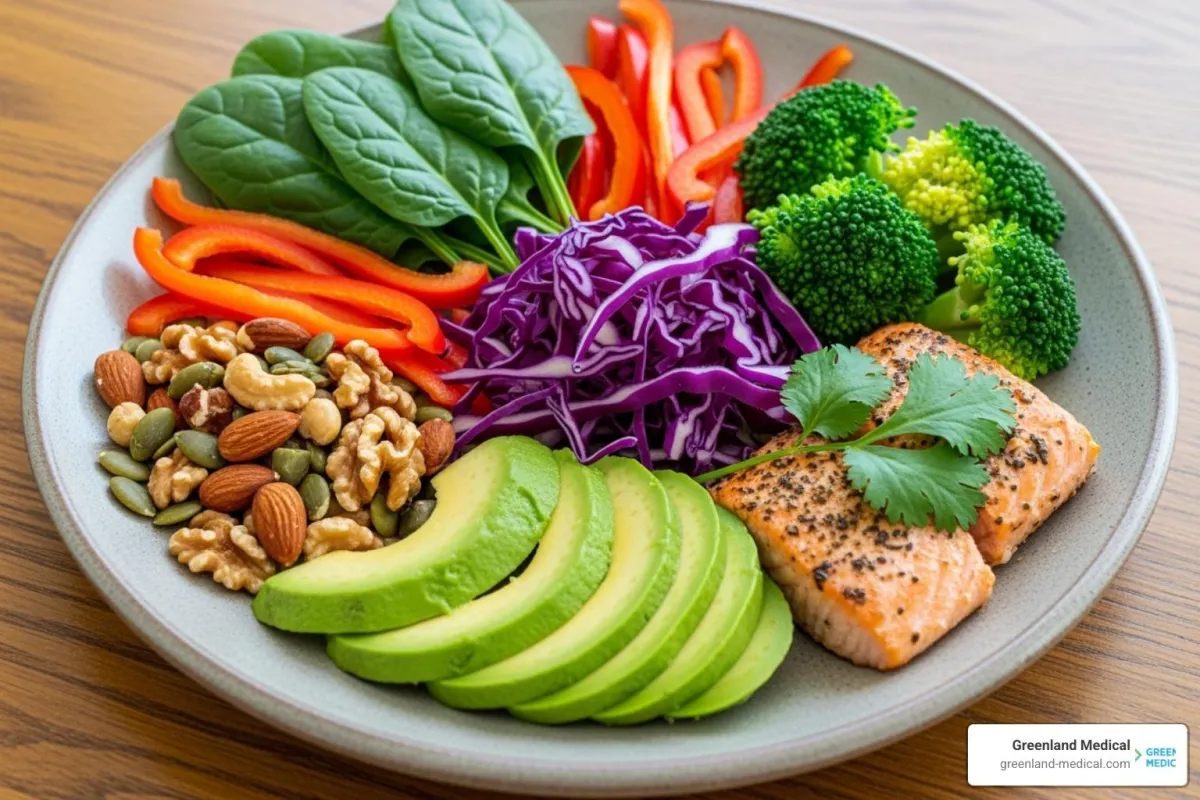
Cooking Up Cognition: Delicious Bredesen Protocol Recipes
Cooking Up Cognition: Your Introduction to the Bredesen Protocol Diet
The bredesen protocol diet is a personalized strategy for optimizing brain health and combating cognitive decline. Here are its core components:
KetoFLEX 12/3 is Key: This combines a mildly ketogenic approach with metabolic flexibility and specific fasting windows.
Mild Ketosis: Aims for your brain to use fat (ketones) for fuel, alongside glucose.
Plant-Rich Focus: Emphasizes a high intake of non-starchy vegetables and healthy fats.
12/3 Fasting: Requires at least 12 hours of overnight fasting and finishing dinner 3 hours before bedtime.
Goal: To improve cognitive function by addressing its multiple underlying causes.
This protocol isn't about a single magic fix. It's about identifying and addressing the many factors that contribute to brain decline. As Dr. Dale Bredesen, the protocol's creator, says, "Imagine you have a roof with 36 holes in it. A drug is an excellent cover for one hole but it doesn’t (stop) the other things." This highlights the comprehensive approach necessary for lasting brain health.
I'm Dr. Andrew Greenland, a Certified Bredesen Protocol Practitioner and integrative functional medicine specialist. I guide patients through the bredesen protocol diet and lifestyle changes, focusing on root-cause resolution for chronic illness and advancing holistic brain health.
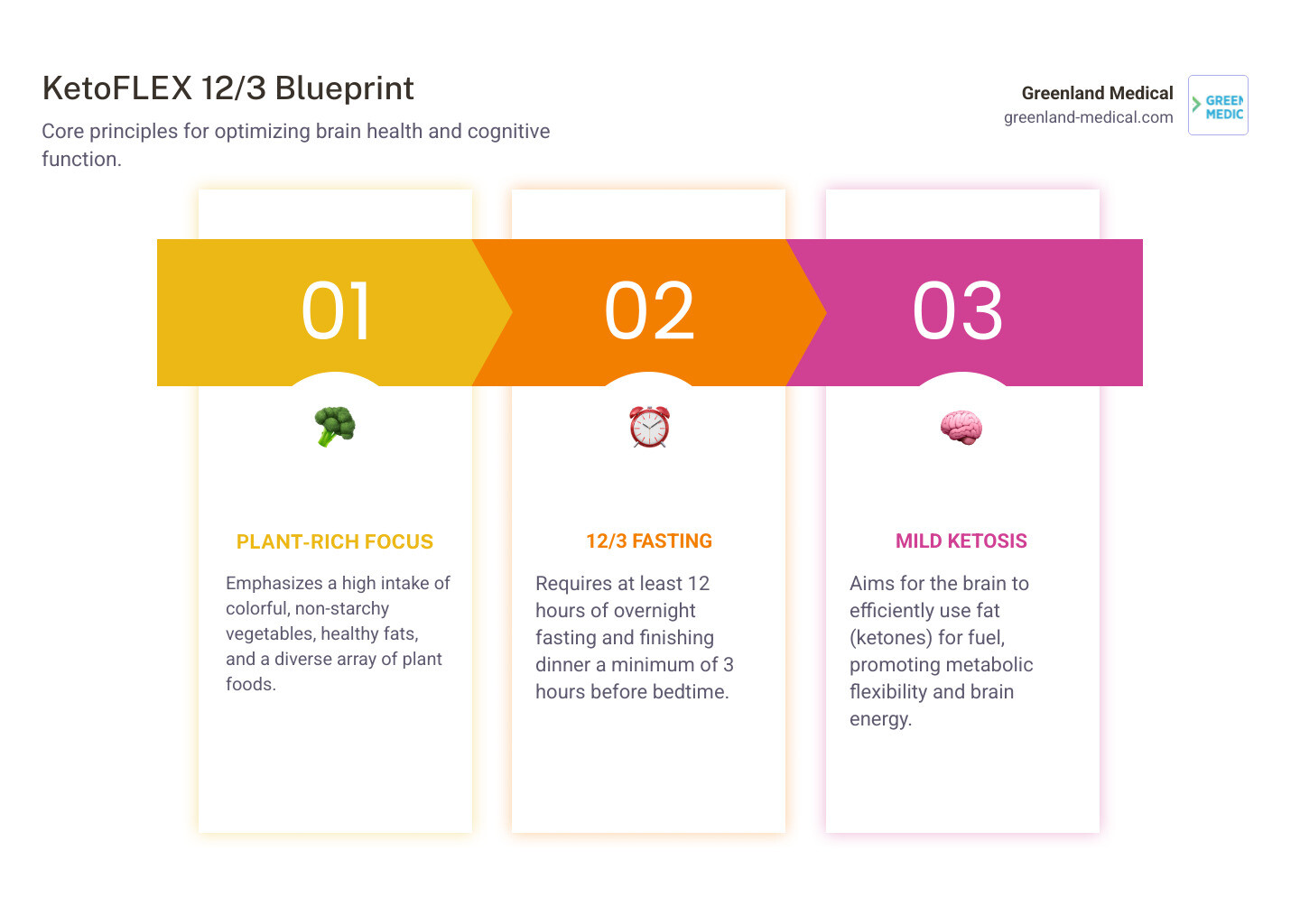
The 'Why' Behind the 'What': Understanding the Bredesen Protocol
At Greenland Medical, we focus on the root cause of health challenges, which is the heart of the Bredesen Protocol diet. Dr. Dale Bredesen, a neurologist who has researched Alzheimer's for over 30 years, revealed that cognitive decline is a complex puzzle. He identified 36 factors that can contribute, including inflammation, insulin resistance, nutrient deficiencies, and toxin exposure.
Dr. Bredesen's theory suggests that Alzheimer's is often the brain's protective response to harm. The amyloid plaques seen as a hallmark of the disease might not be the cause, but rather a response to inflammation, toxins, or metabolic issues. By removing these threats and providing the right support, we can help reverse this protective "downsizing" and encourage the rebuilding of neural connections.
A key part of this strategy is metabolic flexibility, where the brain learns to efficiently use both glucose (sugar) and ketones (from fat) for fuel. When the brain struggles to use glucose, ketones offer a crucial alternative energy source. Achieving mild ketosis, combined with fasting, also triggers autophagy. Think of autophagy as your brain's self-cleaning system, removing damaged proteins and cellular debris, which is vital for peak brain performance.
Furthermore, the protocol aims to boost Brain-Derived Neurotrophic Factor (BDNF). This protein is essential for learning, memory, and the growth of new brain cells. Lifestyle changes, especially diet and exercise, are powerful ways to increase BDNF levels. You can learn more about BDNF here: Brain-derived neurotrophic factor (BDNF).
This comprehensive, personalized approach fits our philosophy of functional medicine. We look at you as a whole person to address underlying imbalances, not just symptoms. Curious to learn more? You can find more information here: More info about functional medicine.
The KetoFLEX 12/3 Blueprint: Your Brain Food Pyramid
The core of the bredesen protocol diet is the KetoFLEX 12/3 eating plan. It's a flexible, plant-rich, mildly ketogenic approach designed to optimize brain fuel and cellular health.
Keto: Refers to mild ketosis (0.5–1.5 mmol/L), training the brain to burn fat for fuel alongside glucose. This is crucial as the brain's ability to use glucose can decline with age. Ketones provide an excellent alternative fuel.
FLEX: Signifies metabolic flexibility (switching between burning glucose and fat) and a flexitarian diet. The diet is heavily plant-based but allows for small amounts of mindfully-sourced animal protein.
12/3: Refers to fasting windows: at least 12 hours of overnight fasting and finishing your last meal at least 3 hours before bed. This promotes autophagy (cellular cleansing) and optimizes repair processes during sleep.
The KetoFLEX 12/3 diet is built around a Brain Food Pyramid to guide your choices.
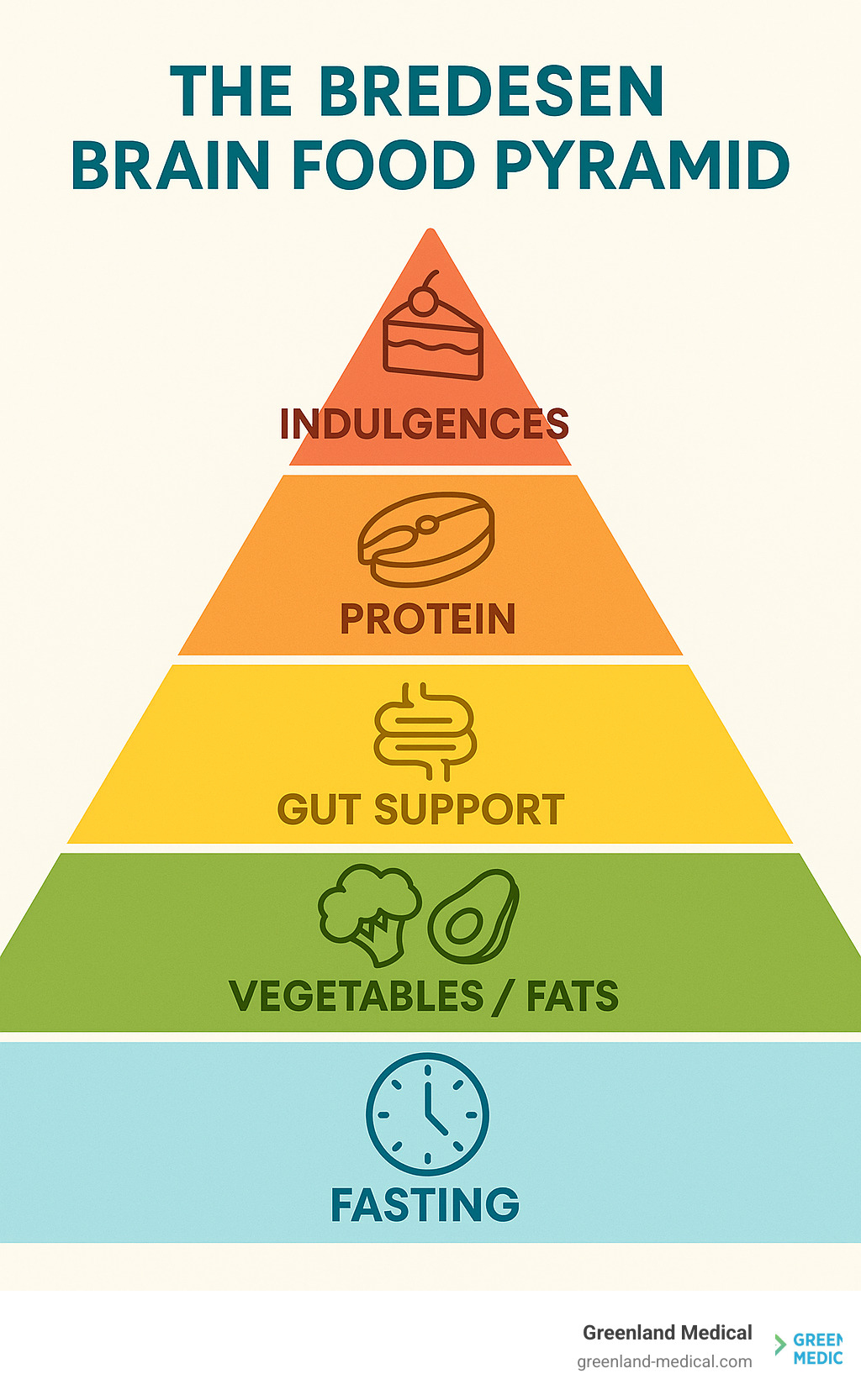
Foods to Accept on the Bredesen Protocol Diet
Focus on nutrient-dense, anti-inflammatory foods that fuel your brain.
Non-starchy Vegetables: The stars of the show. Aim for 6-9 cups of colorful, organic, seasonal vegetables daily. Load up on cruciferous veggies (broccoli, cauliflower) and leafy greens (spinach, kale).
Healthy Fats: Essential for your brain. Emphasize extra virgin olive oil, avocados, nuts (almonds, walnuts), and seeds (chia, flax).
Wild-caught SMASH Fish: "SMASH" stands for Salmon, Mackerel, Anchovies, Sardines, and Herring. These are low-mercury fish rich in omega-3s. Aim for 2-3 ounce servings a few times per week.
Pastured Eggs: A great source of choline and other brain-supportive nutrients.
Brain-loving Herbs & Spices: Incorporate anti-inflammatory spices like turmeric, rosemary, ginger, and cinnamon.
Prebiotic, Probiotic, and Resistant Starch Foods: Vital for gut health. Include mushrooms, onions, garlic (prebiotics); cooled sweet potatoes, beans (resistant starches); and fermented foods like sauerkraut and kimchi (probiotics).
Foods to Avoid or Limit
To minimize inflammation and insulin resistance, avoid or limit these foods:
Sugar and Sweeteners: All forms of added sugar, high-fructose corn syrup, and artificial sweeteners.
Simple Carbohydrates: Foods that rapidly break down into glucose, like white bread, pasta, and most processed snacks. You can learn more about them here: Simple carbohydrates.
Gluten and Grains: Gluten can be inflammatory, and most grains are minimized due to their carbohydrate content.
Conventional Dairy: Often inflammatory. Small amounts of A2, sheep, or goat dairy may be tolerated.
Processed Foods and Industrial Seed Oils: These are typically high in unhealthy fats, sugars, and inflammatory omega-6 fatty acids.
High-mercury Fish: Large predatory fish like shark, swordfish, and king mackerel can accumulate mercury, a neurotoxin.
Understanding your individual sensitivities is also crucial. We often recommend food sensitivity testing to identify specific triggers. You can find more information here: More info about food sensitivity testing.
Your Daily Menu: Recipes for a Sharper Mind
Many patients worry the bredesen protocol diet will be boring, but it's filled with delicious, satisfying meals that align with KetoFLEX 12/3 principles. You'll refind the incredible flavors of fresh herbs, quality fats, and vibrant vegetables.
The KetoFLEX 12/3 approach differs from a standard ketogenic diet:
Feature Standard Ketogenic Diet KetoFLEX 12/3 Diet (Bredesen Protocol) Primary Goal Fat loss, epilepsy management Brain health, cognitive decline prevention/reversal Carb Sources Any low-carb options Primarily non-starchy vegetables, some low-glycemic fruits Protein Limits Moderate to high Moderate (0.8-1.0 g/kg lean body mass), often lower than standard keto Fat Sources Any high-fat options Emphasis on healthy fats: EVOO, avocados, nuts, seeds, SMASH fish Plant Focus Variable Highly plant-rich (6-9 cups veggies daily) Fasting Often incorporates intermittent fasting, but not always specific Specific 12/3 rule (12h overnight, 3h pre-bed) Dairy/Grains Often allowed if low-carb Generally avoided or highly limited (A2 dairy, gluten-free, lectin-free) Ketone Level Moderate to high (1.5-3.0+ mmol/L) Mild (0.5-1.5 mmol/L)
Meal prep is your secret weapon. Batch cooking roasted vegetables, proteins, and dressings on a Sunday means you'll have healthy, ready-to-eat options all week. Building flavor without sugar is an art form, relying on fresh herbs, spices like turmeric and ginger, and the richness of quality olive oil and avocados.
Brain-Boosting Breakfasts (Post-Fast)
Break your fast with nutrient-dense foods for steady energy.
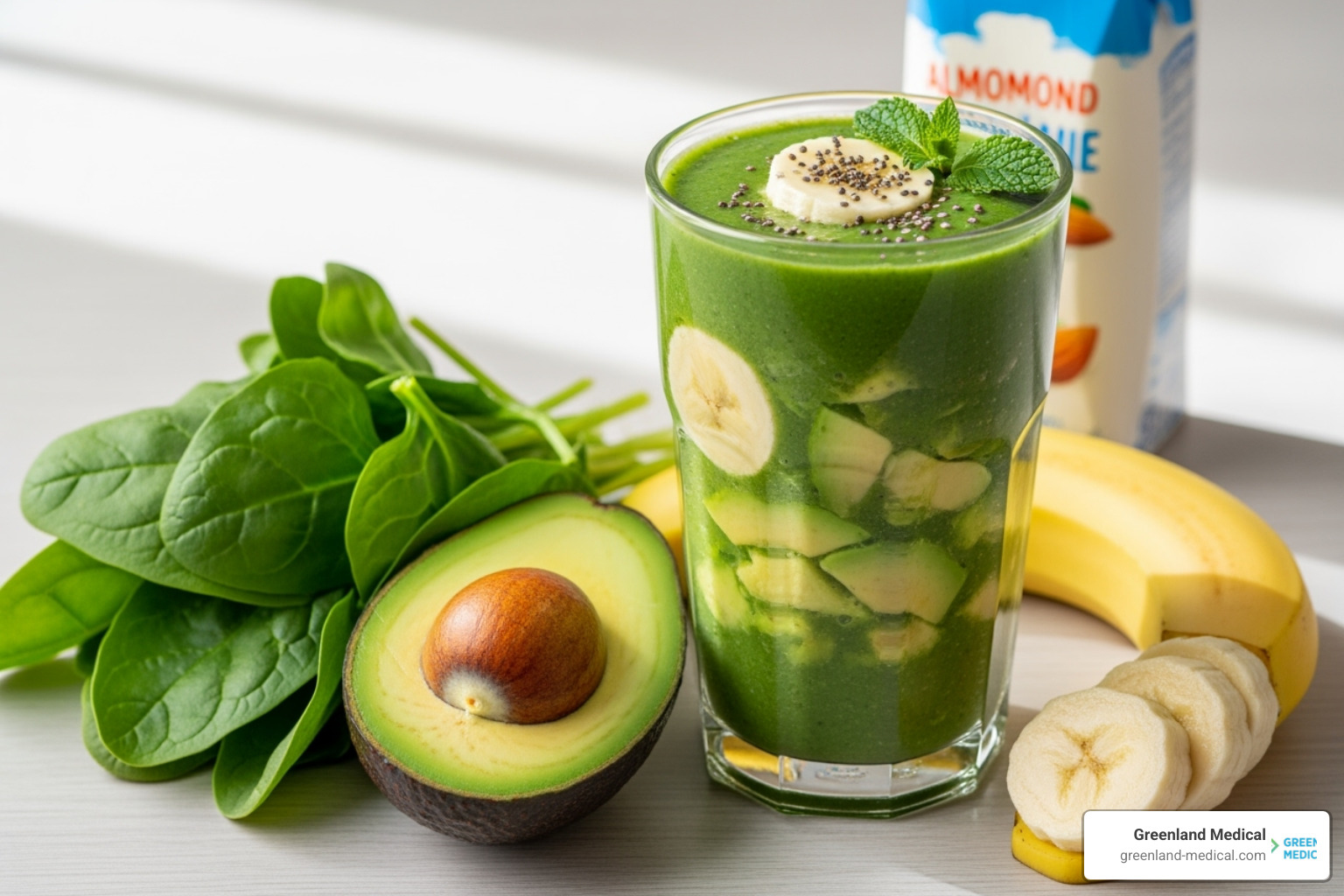
Green Keto Smoothie: Blend 1 cup unsweetened almond milk, 1 cup spinach, 1/2 avocado, and 1 tbsp chia seeds. Add collagen for protein and a few blueberries for antioxidants.
Avocado and Spinach Scramble: Sauté a cup of spinach in olive oil, add 2-3 whisked pastured eggs, and scramble. Stir in diced avocado and a pinch of turmeric.
Chia Seed Pudding: Mix 3 tbsp chia seeds with 1 cup unsweetened coconut milk in a jar and refrigerate overnight. Top with berries and walnuts in the morning.
Energizing Lunches
Your midday meal should prevent an energy crash by combining vegetables, protein, and healthy fats.
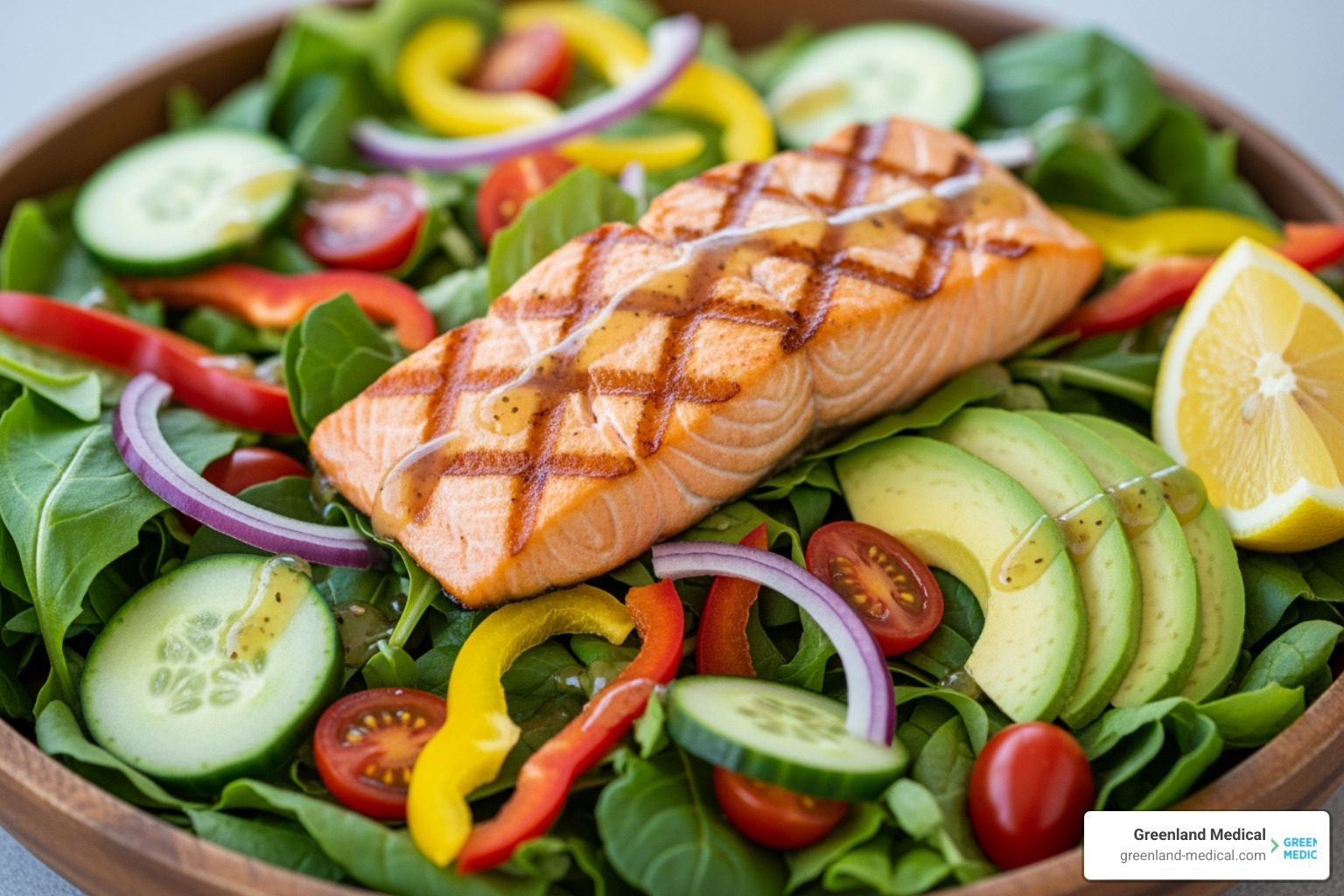
The Ultimate Brain-Boosting Salad: Start with 3-4 cups of mixed greens. Add chopped cucumber, bell peppers, and broccoli. Top with 3-4 ounces of grilled salmon, half a sliced avocado, and a quarter cup of walnuts. For the dressing, whisk together extra virgin olive oil, apple cider vinegar, and Dijon mustard.
Parchment-Baked Cod with Herbs: Place a cod fillet on parchment paper with zucchini, bell peppers, and asparagus. Drizzle with olive oil, season with dill and parsley, and top with lemon slices. Fold into a packet and bake at 400°F for 15-20 minutes.
Satisfying Dinners for Your Bredesen Protocol Diet
Finish eating at least 3 hours before bed to optimize sleep and cellular repair.

Chicken and Broccoli Stir-fry: Stir-fry 4-5 ounces of pastured chicken with broccoli, mushrooms, and bell peppers in coconut oil. For the sauce, mix coconut aminos, apple cider vinegar, minced garlic, and fresh ginger.
Cauliflower Mash with Rosemary: Steam cauliflower florets until tender, then blend with grass-fed ghee, unsweetened almond milk, and fresh rosemary. Season with salt and pepper.
Grass-fed Beef Burger with Sautéed Mushrooms: Cook a grass-fed beef patty and serve in a lettuce wrap instead of a bun. Top with sautéed mushrooms, sliced avocado, and tomato.
Beyond the Plate: Lifestyle Pillars for Cognitive Health
While the bredesen protocol diet is foundational, optimal brain health requires a comprehensive lifestyle approach. The most dramatic cognitive improvements occur when patients accept all pillars working together.
Exercise is medicine for your brain. Movement helps grow new brain cells and strengthen connections. We recommend combining aerobic activity (at least 150 minutes per week of brisk walking, swimming, or cycling) with strength training 3-4 times weekly. Even a 20-minute walk after dinner can boost cerebral blood flow and increase BDNF production.
Sleep hygiene is critical. During 7-8 hours of quality sleep, your brain's glymphatic system washes away toxins like beta-amyloid. As Dr. Bredesen says, "It's a badge of courage to not have much sleep and it turns out this is horrible for your cognition." Create consistent sleep habits by maintaining a regular schedule, keeping your bedroom dark and cool, and avoiding screens before bed. Addressing sleep disorders like sleep apnea is essential.
Stress management is not a luxury; chronic stress is damaging to the brain. High levels of the stress hormone cortisol create inflammation and can shrink memory centers. Meditation, yoga, deep breathing, and time in nature help reset your stress response and build resilience.
Detoxification support is important in our modern world. We are exposed to "dementogens"—brain-damaging toxins like heavy metals, mold, and pesticides. The protocol emphasizes identifying and reducing personal exposures and supporting your body's natural detox pathways.
Oral hygiene also plays a direct role. Poor dental care can lead to chronic inflammation that may contribute to cognitive decline. Diligent brushing, flossing, and regular dental visits are an important piece of the puzzle.
These pillars work synergistically with diet to create an environment where your brain can thrive. Our naturopathy services focus on these interventions to support your journey. You can learn more here: More info about naturopathy services. Small, consistent improvements in each pillar compound over time.
Navigating the Science and Practicalities
The Bredesen Protocol is a powerful, personalized approach to cognitive health, designed to fit your unique needs.
Personalization is Key
A 'cognoscopy'—a comprehensive assessment—kicks off the journey. This involves extensive lab work (looking at inflammatory markers, hormones, nutrient levels), genetic testing (like for APOE4 status), and neurocognitive evaluations. This data helps identify your specific challenges among Dr. Bredesen's six Alzheimer's subtypes (e.g., inflammatory, toxic). This allows for a truly personalized program, often guided by Apollo Health's PreCODE (prevention) and ReCODE (reversal) programs.
Scientific Evidence
Dr. Bredesen's work is the result of over 30 years of research. His clinical trials and case series have shown promising outcomes, with many participants reporting significant improvements or reversals in cognitive decline. One key paper sharing these findings is available here: Bredesen's case series research. These results suggest a multi-faceted approach can be effective where single-drug therapies have failed.
Scientific Criticism
Like many innovative approaches, the protocol has faced criticism. Some point out that case series studies, while valuable, lack control groups, making it hard to prove the protocol is solely responsible for improvements. Concerns have also been raised about the need for more large-scale, placebo-controlled trials. A Lancet Neurology editorial highlighted some of these points: Lancet Neurology editorial concerns. The Alzheimer's Association has also stated it awaits more rigorous evidence. Dr. Bredesen suggests such scrutiny is common for disruptive medical ideas.
Practical Challenges
Adopting the bredesen protocol diet and its lifestyle changes is a significant commitment, requiring discipline and a shift in daily habits. Juggling meal prep, fasting windows, exercise, and stress reduction can feel overwhelming at first. It's a journey, not a sprint.
Cost Considerations
The protocol involves various expenses. The core ReCODE package can be around USD $1399, with custom supplements adding over USD $150 per month, plus costs for testing and practitioner fees. While substantial, it's worth weighing these costs against the immense financial and emotional burden of Alzheimer's disease, where informal care alone can cost thousands per year. Investing in prevention can offer significant long-term value.
Working with a Practitioner
Given the protocol's personalized nature, working with a certified practitioner is invaluable. A practitioner helps interpret test results, craft a custom plan, guide you through adjustments, and provide ongoing support. This expert guidance ensures the protocol is implemented safely and effectively.
Frequently Asked Questions about the Bredesen Protocol Diet
Here are answers to the most common questions I receive from patients starting the bredesen protocol diet.
Can I follow this diet if I'm vegetarian or vegan?
Yes. The protocol is naturally plant-friendly, emphasizing 6-9 cups of non-starchy vegetables daily. The foundation of vegetables, healthy fats, and gut-supporting foods aligns perfectly with plant-based eating.
Vegetarians can include pastured eggs, legumes (soaked and sprouted), nuts, and seeds as protein sources.
Vegans will focus on these same plant-based proteins, requiring careful planning to get complete amino acid profiles.
For both, B12 and DHA supplementation are non-negotiable, as these brain-critical nutrients are primarily found in animal products. We use high-quality, algae-based DHA. With careful planning, you can thrive on a plant-based version of the protocol.
How long does it take to see results on the protocol?
This varies significantly from person to person. Some people notice improved energy, sleep, and mental clarity within weeks as inflammation reduces. More substantial cognitive improvements can take several months, especially when addressing multiple root causes.
Your timeline depends on your baseline cognitive function, consistency with the full protocol, genetics (like APOE4 status), and the number of issues being addressed. Early intervention typically leads to faster, more dramatic improvements. The key is consistency and patience.
Is the Bredesen Protocol safe?
Generally, the bredesen protocol diet is very safe because it is built on whole, unprocessed, nutrient-dense foods. The core recommendations—more vegetables, healthy fats, exercise, and sleep—are universally recognized as beneficial.
However, because the protocol involves significant dietary shifts, fasting, and targeted supplements, it is crucial to work with a healthcare professional, especially if you have pre-existing conditions.
For example, those with diabetes require careful blood sugar monitoring. Protein intake may be modified for those with kidney disease. Patients with a history of eating disorders need extra support. Professional guidance ensures the protocol is implemented safely and custom to your unique health profile, optimizing brain health without creating new problems.
Conclusion
The journey to a healthier brain is a powerful one, and the bredesen protocol diet, with its KetoFLEX 12/3 plan, is a cornerstone of that journey. It is a science-backed nutritional strategy that tackles the multiple underlying causes of cognitive decline.
This approach helps your brain become metabolically flexible, cleans out damaged cells, and provides nutrient-rich, anti-inflammatory foods. It offers a hopeful and empowering path to protect and even improve your cognitive function. It's not just a diet; it's a new way of living that puts your brain first.
When combined with vital lifestyle choices—exercise, quality sleep, stress management, and detoxification—your brain gets the best possible chance to flourish. While these changes require commitment, the rewards of a sharper mind, more energy, and a reduced risk of cognitive decline are priceless.
At Greenland Medical, we understand that starting a comprehensive protocol can feel overwhelming. We offer expert guidance and personalized support every step of the way. We believe your cognitive future is in your hands, and with the right tools, you can take proactive steps towards lasting brain health.
Ready to start cooking up cognition with us? Learn more about our unique approach to the Bredesen Protocol and how we can help you on this path: Learn more about our approach to the Bredesen Protocol.
